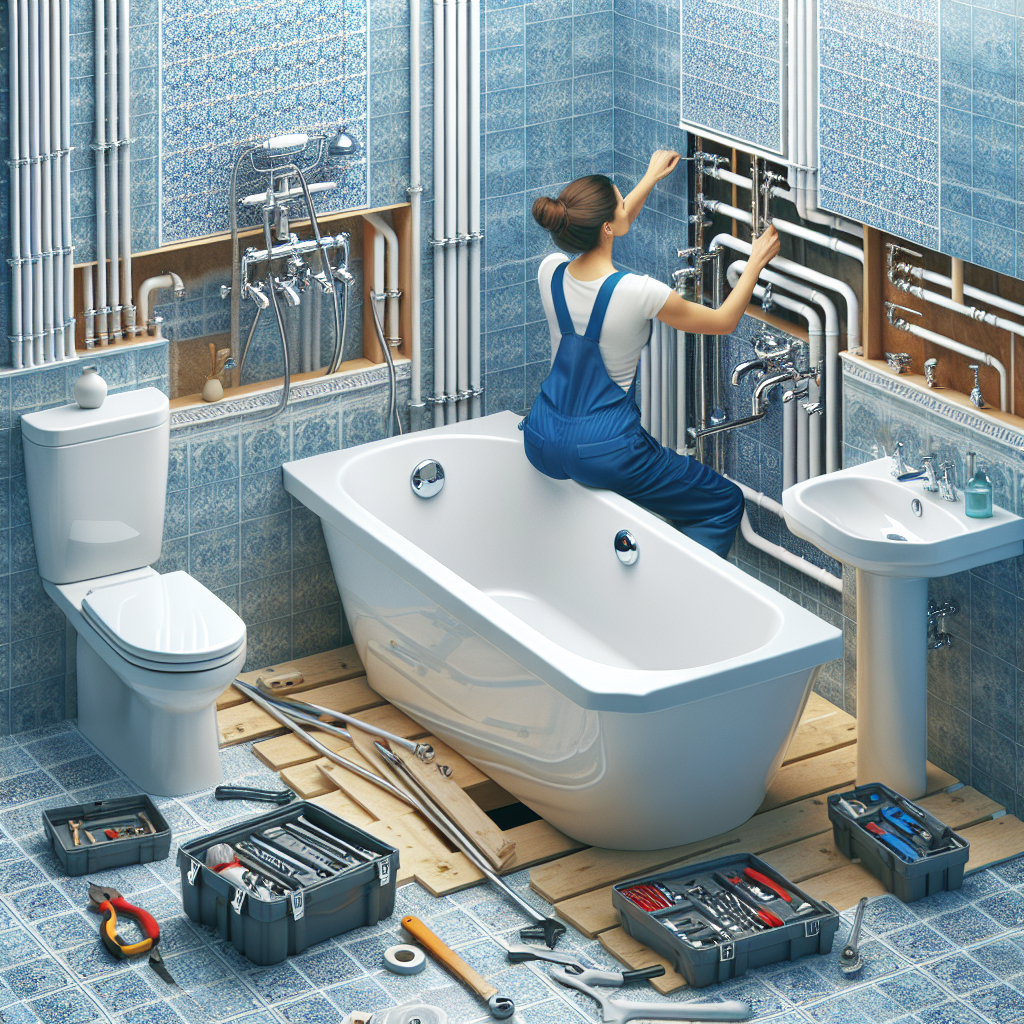Bathtub Installation: A Comprehensive Guide

Installing a bathtub is a significant home improvement project that can enhance the functionality and aesthetics of your bathroom. Whether you’re remodeling your bathroom or building a new home, choosing the right bathtub and ensuring proper installation are crucial for a successful project. In this article, we will explore the various aspects of bathtub installation, including the types of bathtubs available, the installation process, and important considerations to keep in mind. We will also address frequently asked questions about bathtub installation to provide you with a comprehensive understanding of this topic.
Types of Bathtubs
Before diving into the installation process, it’s essential to familiarize yourself with the different types of bathtubs available. Each type offers unique features and benefits, catering to different preferences and needs. Here are some popular types of bathtubs:
1. Alcove Bathtubs
Alcove bathtubs are the most common and versatile type of bathtub. They are designed to fit into a three-walled enclosure, with one side open for easy access. Alcove bathtubs are an excellent choice for small bathrooms or when space is limited.
2. Freestanding Bathtubs
Freestanding bathtubs are standalone fixtures that can be placed anywhere in the bathroom. They are known for their elegant and luxurious appearance, making them a popular choice for modern and contemporary bathroom designs. Freestanding bathtubs come in various shapes, including oval, rectangular, and clawfoot.
3. Corner Bathtubs
Corner bathtubs are designed to fit snugly into the corner of a bathroom. They are an excellent option for maximizing space and creating a spa-like atmosphere. Corner bathtubs are available in various sizes and shapes, allowing you to choose the one that best suits your bathroom layout.
4. Drop-In Bathtubs
Drop-in bathtubs are installed by dropping them into a pre-built frame or platform. They offer a seamless and integrated look, as the rim of the bathtub is hidden within the surrounding structure. Drop-in bathtubs provide flexibility in terms of design and customization.
5. Walk-In Bathtubs
Walk-in bathtubs are designed with accessibility in mind, making them an ideal choice for individuals with mobility issues or seniors. These bathtubs have a door that allows users to enter and exit easily without having to step over the rim. Walk-in bathtubs often come equipped with safety features such as grab bars and non-slip surfaces.
The Bathtub Installation Process
Proper installation is crucial to ensure the longevity and functionality of your bathtub. While it’s recommended to hire a professional contractor for the installation, understanding the process can help you make informed decisions and communicate effectively with the contractor. Here are the general steps involved in bathtub installation:
1. Preparation
The first step in bathtub installation is preparing the bathroom. This involves removing any existing fixtures, such as the old bathtub, shower, or tiles. The area where the new bathtub will be installed should be clean and free from debris. It’s also important to ensure that the plumbing and electrical connections are in place.
2. Positioning
Once the bathroom is prepared, the next step is positioning the bathtub. The exact placement will depend on the type of bathtub and the bathroom layout. It’s crucial to ensure that the bathtub is level and properly aligned with the plumbing connections. This step requires precision to avoid any future issues, such as leaks or drainage problems.
3. Plumbing and Electrical Connections
After positioning the bathtub, the plumbing and electrical connections need to be installed. This includes connecting the water supply lines, drain pipes, and any necessary electrical wiring for features like jets or whirlpool systems. It’s essential to follow local building codes and regulations to ensure safety and compliance.
4. Securing and Sealing
Once the plumbing and electrical connections are in place, the bathtub needs to be secured and sealed. This involves attaching the bathtub to the surrounding walls or floor to prevent movement or shifting. Proper sealing is crucial to prevent water leakage and damage to the surrounding areas. Silicone caulk is commonly used for sealing the edges of the bathtub.
5. Finishing Touches
After securing and sealing the bathtub, the final step is to complete the finishing touches. This may include installing any additional fixtures, such as faucets, showerheads, or handles. It’s important to test the bathtub and ensure that all components are functioning correctly before completing the installation process.
Important Considerations for Bathtub Installation
While the installation process may seem straightforward, there are several important considerations to keep in mind to ensure a successful bathtub installation. Here are some key factors to consider:
1. Bathroom Layout and Space
Before choosing a bathtub, assess your bathroom layout and available space. Consider the dimensions of the bathtub and how it will fit into the existing bathroom design. Ensure that there is enough space for comfortable access and movement around the bathtub.
2. Plumbing and Electrical Requirements
Understanding the plumbing and electrical requirements is crucial for a smooth installation process. Consult with a professional plumber and electrician to ensure that the necessary connections are in place and meet local building codes. This will help avoid any potential issues or delays during the installation.
3. Material and Durability
Consider the material and durability of the bathtub. Different materials, such as acrylic, fiberglass, or cast iron, offer varying levels of durability and maintenance requirements. Choose a material that suits your preferences and budget while ensuring long-term durability.
4. Accessibility and Safety
If accessibility is a concern, opt for a bathtub that offers features such as grab bars, non-slip surfaces, and easy entry and exit options. This is particularly important for individuals with mobility issues or seniors. Prioritize safety and comfort when selecting a bathtub.
5. Budget and Cost
Set a budget for your bathtub installation project and consider the overall cost, including the bathtub itself, installation fees, and any additional fixtures or accessories. Research different options and compare prices to ensure that you stay within your budget while still achieving your desired outcome.
Frequently Asked Questions about Bathtub Installation
1. What is the average cost of bathtub installation?
The cost of bathtub installation can vary depending on various factors, such as the type of bathtub, complexity of the installation, and location. On average, the cost can range from $500 to $3,000, including the bathtub and installation fees. It’s recommended to obtain quotes from multiple contractors to get an accurate estimate for your specific project.
2. How long does bathtub installation take?
The duration of bathtub installation depends on the complexity of the project and the contractor’s efficiency. On average, it can take anywhere from one to three days to complete the installation. However, this timeline may vary based on factors such as the bathroom’s condition, plumbing requirements, and any additional customization or modifications.
3. Can I install a bathtub myself?
While it’s possible to install a bathtub yourself, it’s generally recommended to hire a professional contractor. Bathtub installation involves complex plumbing and electrical work, as well as precise positioning and sealing. Hiring a professional ensures that the installation is done correctly and reduces the risk of future issues or damage.
4. How do I maintain and clean my bathtub?
The maintenance and cleaning requirements for your bathtub will depend on the material. Generally, it’s recommended to clean the bathtub regularly using mild soap or a non-abrasive cleaner. Avoid using harsh chemicals or abrasive scrubbers that can damage the surface. Follow the manufacturer’s instructions for specific cleaning and maintenance guidelines.
5. Can I replace my old bathtub with a different type?
Yes, it’s possible to replace your old bathtub with a different type. However, keep in mind that this may require additional modifications to the plumbing and electrical connections. Consult with a professional contractor to assess the feasibility of replacing your old bathtub with the desired type and to ensure a smooth transition.
Summary
Bathtub installation is a significant home improvement project that requires careful consideration and planning. Understanding the different types of bathtubs, the installation process, and important considerations can help you make informed decisions and achieve the desired outcome. Hiring a professional contractor is recommended to ensure a successful installation and avoid any potential issues. Remember to assess your bathroom layout, consider accessibility and safety features, and set a budget for your bathtub installation project. By following these guidelines, you can transform your bathroom into a functional and relaxing space.

